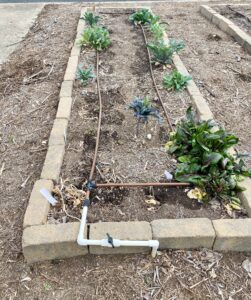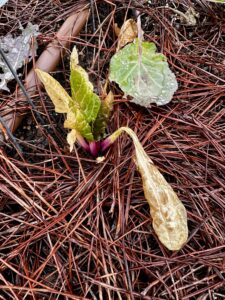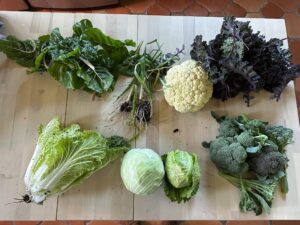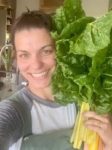The Austin February Vegetable Garden Checklist by Paula Wolfel

A February Garden: remnants from the winter and space for the spring.
This month is filled with multi-tasking in the garden. For those who have a winter garden, you will spend this month cleaning up from last’s month’s freeze and continuing to be on the defense, protecting your garden from temperatures that drop below 32 degrees. Take advantage of the warm days and pull weeds and pick and discard any frozen/defrosted, dead leaves or plants. Early in the month, work 1-2” of compost into your soil and put a layer of fresh soil into beds if it is needed. Cover the compost and new soil with mulch to protect it and keep it fresh for your spring garden. Finally, there are a plentitude of cool season plants and seeds that can be put into the ground this month. And there are several seeds that can be started inside and transferred outside in March-April. Keep warm Austin!
The Importance of the Last and the First Frost Dates
How does frost affect plants? Plants absorb heat from the sun during the day. On cold nights, plants quickly lose this stored heat. As air temperature drops, moisture in the air condenses into dew, which then freezes on leaves and stems and turns to frost when the temperatures drop to 32 degrees. When temperatures drop below 32 degrees, ice crystals form inside plant cells and rupture them, killing plant tissue and sometimes the whole plant. Clouds trap heat so they insulate the atmosphere, therefore adding a layer of insulation to plants, potentially protecting them from freeze damage. Frost and freeze are therefore more likely to occur on cold, clear nights. Read more here.
When is the average last frost date in Austin?

Frost damaged chard leaves.
The average last frost date for the Austin area is February 25th. This date is important in determining when to plant frost-sensitive vegetables and when to move your indoor seedlings outside. In general, a frost will kill beans, cantaloupe, corn, cucumbers, eggplant, okra, peas, pepper, potatoes, sweet potatoes, squash, tomatoes, and watermelon. Colder temperatures (26-31) may burn foliage (symptoms will be shriveled, brown or black leaves) but will not kill broccoli, cabbage, cauliflower, chard, lettuce, mustard, onion, radish turnip. Cold weather champs are beets, Brussel sprouts, carrots, collards, kale, parsley, spinach.
No Dawdling on Spring Planting!
The goal is to get plants into the ground before the summer heat sets in. The optimal growing season is from the last spring freeze through early summer. And then again in the fall, we have the option of getting more frost sensitive plants into the ground once the intense heat dissipates and before the first fall freeze. You can get a head start growing frost sensitive plants by growing seeds inside during the winter or purchasing larger transplants in the spring.
The USDA Plant Hardiness Zone Map helps home gardeners navigate what plants can grow in your area. The zones indicate what the lowest winter temperatures will likely be in your area based on historical records. You can zoom into the map to get more precise location information. When buying plants and seeds, make sure you check the zone that plant can grow in.
Austin February Vegetable Garden Checklist
Here is what you can do in the garden this month:
Fertilize
- Send in soil samples to get an analysis on what your soil may be lacking https://soiltesting.tamu.edu/soil-testing/
- Feed vegetables with fish emulsion or other water-soluble fertilizers every two weeks
Water
- Irrigate only if the soil is dry a few inches below the surface
- Give your plants a good watering before a freeze- moist soil will be warmer and well-watered plants that are not stressed will be less susceptible to freeze damage
Planting
Seeds:
- Carrots (all month)
- Peas: English, snap and snow (early month)
- Potatoes: Irish (all month)
- Radishes (all month)
- Turnips (all month)
Transplants:
- Asparagus- crowns (all month)
- Broccoli (all month)
- Cabbage (all month)
- Cauliflower (all month)
- Onions, bulbing (first of month)
Seed or Transplants:
- Arugula (all month)
- Asian Greens (all month)
- Beets (all month)
- Chard, Swiss (all month)
- Collards (all month)
- Fennel (all month)
- Greens-cool season- (all month)
- Kale (all month)
- Kohlrabi (all month)
- Leeks (early month)
- Lettuce, Head and Leaf (all month)
- Mustard (all month)
- Spinach (all month)
Indoor Seed Starting:
- Cantaloupes
- Cucumbers
- Eggplants
- Peppers
- Tomatoes
- Watermelon
Soil
- Use mild days to turn compost and add organic material to your soil
- Keep soil covered with mulch even if the garden is empty to protect the nutrients in your soil and maintain soil moisture
Diseases/Pests to Look for
- With warmer weather coming, start making your garden an unwelcoming place for pests by taking out weeds and cleaning up debris.
Maintenance
- Check to make sure your irrigation system is ready for spring. Annual inspections and adjustments are recommended to maintain the performance, check for leaks or burst pipes, and prevent the waste of water.
- Clean and sharpen your tools.
Harvest
- Keep an eye on the root vegetables that were planted late fall. I have been harvesting radishes the last few weeks.
- Arugula, Kale, Chard, Spinach, Lettuces are ready to harvest as soon as there is a leaf! The younger, more tender leaves will be in the inside. Harvest some leaves with bunching onions, radishes, and herbs and make a fresh salad.
- Harvest the leaves of mustard greens and Asian greens and make a stir fry.
- Harvest cabbage, bunching onions, and radishes and ferment them into kimchi or beets and cabbage and ferment into sauerkraut
- Finally, broccoli and cauliflower can be eaten raw with ranch dip, steamed and tossed with olive oil and fresh lemon, or cooked alongside other vegetables into soup.

February Harvest: cabbage and onions ready for kimchi and brassicas ready for soup.
Additional Resources
Weather Strategies for Austin Gardens
Watch the Vegetable Gardening in Central Texas Webinar
Vegetable Planting Calendar (Español, 繁体中文)
Recommended Vegetable Varieties for Travis County
Easy Gardening Series Detailed tips from Texas A&M University AgriLife Extension on specific crops and practices.
Vegetable Gardening in Austin Resource hub for all things vegetables for Travis County
Plant Rotations, Successions and Intercropping
Monthly Gardening Calendar for Austin and Central Texas
Sustainable Food Center Farmers Markets
About Paula Wolfel
 Paula Wolfel joined the Travis County Master Gardener program in 2022, but has been gardening in Austin, Texas since 2017. She grew up in the suburbs of Chicago learning how to garden from both her father—a Sicilian vegetable and fruit tree gardener—and both her grandmothers, and then spent years in Virginia gardening. Paula loves gardening because she finds it to be a grounding force- it gets her out of her head and into the present. She loves the pride that comes with cooking a meal for her family with every ingredient coming from her garden… and then the humility she feels when she loses an entire crop because of Mother Nature. She finds gardening to be wisdom, lessons, best practices passed down generation to generation, season to season and hopes to share that with you.
Paula Wolfel joined the Travis County Master Gardener program in 2022, but has been gardening in Austin, Texas since 2017. She grew up in the suburbs of Chicago learning how to garden from both her father—a Sicilian vegetable and fruit tree gardener—and both her grandmothers, and then spent years in Virginia gardening. Paula loves gardening because she finds it to be a grounding force- it gets her out of her head and into the present. She loves the pride that comes with cooking a meal for her family with every ingredient coming from her garden… and then the humility she feels when she loses an entire crop because of Mother Nature. She finds gardening to be wisdom, lessons, best practices passed down generation to generation, season to season and hopes to share that with you.
